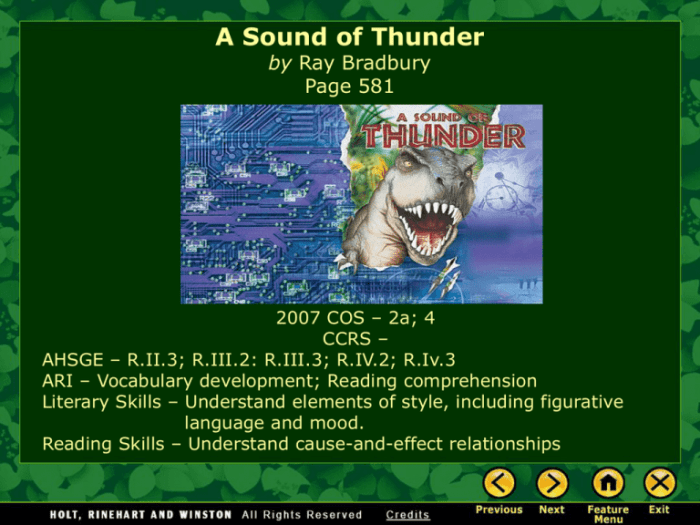Conflict of a sound of thunder – Delving into the heart of Ray Bradbury’s “A Sound of Thunder,” we embark on a journey where the delicate balance of time and consequence hangs precariously. The conflict at the core of this gripping tale sets the stage for an exploration of the profound impact of our actions, both in the present and the future.
As we navigate the complexities of time travel, the characters’ motivations and actions become entangled in a web of ethical dilemmas. The ripple effects of altering the past unfold before our eyes, challenging our understanding of cause and effect.
Literary Analysis

Ray Bradbury’s “A Sound of Thunder” is a classic science fiction tale that explores the complexities of time travel and its potential consequences. The central conflict of the story revolves around the tension between the desire to alter the past and the unforeseen repercussions that may arise from such actions.
The Butterfly Effect
The story introduces the concept of the butterfly effect, which posits that even the smallest changes to the past can have far-reaching and unpredictable consequences. This is exemplified by the protagonist, Eckels, who travels back in time to hunt a dinosaur.
Despite being instructed to stay on the designated path, Eckels’s curiosity gets the better of him, and he steps off the path, crushing a butterfly.
Upon returning to the present, Eckels and his fellow travelers discover that the world they left behind has undergone significant alterations. The political landscape has shifted, and the social climate has become oppressive. This stark contrast highlights the profound impact that seemingly insignificant actions can have on the course of history.
Historical Context

Ray Bradbury’s “A Sound of Thunder” is set in the year 2055, a time of advanced technology and scientific progress. However, the story also reflects the anxieties and fears of the mid-20th century, when it was written.
Social and Cultural Influences
The mid-20th century was a time of great social and cultural change. The world was recovering from the devastation of World War II, and the Cold War was escalating. People were concerned about the threat of nuclear war and the potential for scientific advancements to be used for destructive purposes.
These fears are reflected in “A Sound of Thunder.” The story is set in a world where time travel is possible, but it is strictly regulated to prevent any changes to the past. The main character, Eckels, is warned that even the smallest change could have disastrous consequences.
Reflections of the Time
“A Sound of Thunder” reflects the anxieties of its time by exploring the dangers of scientific advancements and the importance of preserving the past. The story also warns against the dangers of hubris and the belief that humans can control the natural world.
Scientific Exploration

Ray Bradbury’s “A Sound of Thunder” explores the concept of time travel through the lens of science fiction. The story depicts a time machine that allows individuals to travel back to the prehistoric era, specifically 66 million years in the past.
The scientific principles behind the time machine in the story are not explicitly explained. However, Bradbury hints at the possibility of using advanced technology to manipulate the space-time continuum. The machine is described as a “silver sphere,” suggesting a futuristic device that utilizes unknown scientific principles.
The conflict in “A Sound of Thunder” highlights the delicate balance between scientific advancement and the preservation of the natural world. To gain a deeper understanding of the complexities of scientific responsibility, it’s essential to consult reliable sources like the vita basic exam answers 2022 . By exploring these resources, we can better grasp the potential consequences of our actions and make informed decisions that safeguard both human progress and the delicate ecosystems that sustain us.
Ethical Implications of Altering the Past
One of the central themes of the story is the ethical implications of altering the past. Bradbury raises questions about the potential consequences of changing even the smallest details of history. The protagonist, Eckels, accidentally steps on a butterfly during his time-traveling expedition, creating a ripple effect that leads to significant changes in the present.
- The Butterfly Effect:The story illustrates the “butterfly effect,” which suggests that even minor changes in the past can have profound and unpredictable consequences in the future.
- Responsibility for Actions:The story emphasizes the responsibility that comes with altering the past. Eckels’ actions, though seemingly insignificant, have far-reaching effects, highlighting the importance of careful consideration before making decisions that could impact history.
Potential Consequences of Time Travel
Bradbury also explores the potential consequences of time travel beyond the ethical implications. The story raises questions about the paradoxes and uncertainties that could arise from manipulating the past.
- Temporal Paradoxes:The story hints at the possibility of creating temporal paradoxes, such as the grandfather paradox, where an individual travels back in time and prevents their own birth.
- Unintended Consequences:Bradbury suggests that time travel could have unintended consequences, both positive and negative. Eckels’ actions, while intended to be harmless, ultimately lead to unforeseen changes in the present.
- The Limits of Knowledge:The story highlights the limits of human knowledge and the dangers of assuming that we can fully understand the complexities of time travel and its potential consequences.
Cultural Impact: Conflict Of A Sound Of Thunder

Ray Bradbury’s “A Sound of Thunder” has left an enduring mark on popular culture, influencing countless works of literature, film, and television. Its exploration of the butterfly effect and the fragility of history has resonated with audiences for decades.
Adaptations and References
The story has been adapted into several films, including the 1952 short film “The Sound of Thunder” and the 2005 feature film of the same name. It has also inspired numerous episodes of television shows, such as “The Twilight Zone,” “Star Trek,” and “Doctor Who.”
Beyond adaptations, “A Sound of Thunder” has been referenced and parodied in various works of art. For instance, the popular video game series “Fallout” features a mission where players must travel back in time to prevent a nuclear war, echoing the story’s central premise.
Legacy and Relevance, Conflict of a sound of thunder
The enduring legacy of “A Sound of Thunder” lies in its timeless themes of responsibility, unintended consequences, and the importance of preserving the past. Its message has become increasingly relevant in an era of rapid technological advancements and global interconnectedness.
The story continues to be taught in schools and universities, serving as a cautionary tale about the dangers of tampering with the natural order and the need for careful consideration before taking actions that could have far-reaching effects.
FAQ Insights
What is the central conflict in “A Sound of Thunder”?
The central conflict revolves around the ethical implications of time travel and the unintended consequences of altering the past.
How does the butterfly effect play a role in the story?
The butterfly effect demonstrates how seemingly insignificant actions can have far-reaching and unpredictable consequences.
What are the motivations of the main characters?
The characters are driven by a desire for adventure, profit, and the thrill of altering history, but their actions ultimately lead to unintended and devastating consequences.